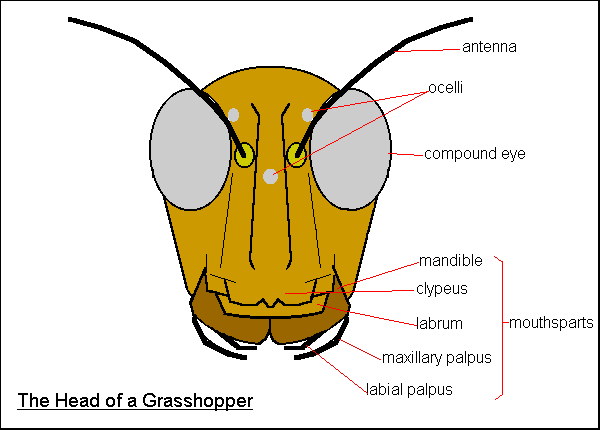|
|
Grasshopper's Face
- Grasshoppers have large compound eyes and can see you meters away. If you approach near to them, they try to hide behind the leaves or branches, but will still peep at you by either one of their large eyes. Below the eyes is the chewing mouth. With the antenna and ocelli, which form the typical insect face.

Let's get familiar with the the grasshopper's face. Actually the insect face is not much different from us. The insect face, like our face, is what "goes forward" to meet the environment. For most insects, like this grasshopper, it is equipped with all types of sensory organs. There are eyes to see , antennae to touch, smell and taste, mouthparts to taste. The face is responsible for much of the sensory input into an insect. Let's now look at the each parts on the grasshopper's face.
Antenna - A pair of jointed appendages located on the head of an insect above the mouthparts. Antenna is something like our nose but sense more information than our nose. It perceives odours, touch, humidity, vibration, wind velocity and direction.
Ocelli - Also known as simple Eyes. Those eyes can only detect light intensity and not actually see anything. It is believed that they help to find the sea-level or horizontal during flying.
Compound Eye - There are usually two compound eyes, located on each side of the head. Each eye composes of a number of individual units called ommatidia , which is marked by a hexagonal facet. Compound eyes can see shape, colour, movement, and tell the distance. Grasshoppers have large compound eyes and and have a board field of vision.
Mouthparts - Mouthparts have evolved for special needs for different insects. They can chew, suck, pierce, lap, and sponge-up their food. Grasshopper has the most primitive type of mouthparts for chewing. Basically all types of mouthparts are evolved from the chewing type. The labrum is suspended from the clypeus and form the upper lip. Their function is to help keep food in the mouth. The mandibles are transverse jaws for cutting and grinding. Behind the mandibles there is the maxillae. The maxillae also function as a set of jaws for food manipulation. The labium functions as a lower lip. Maxillary palpus and labial palpus are used for touching, tasting, and sensing temperature.
- Reference:
- 1. Animals Without Backbones, Ralph Buchsbaum, Pelican / Penguin Books,1968, pp 303.
- 2. Insects of Australia, CSIRO, Division of Entomology, Melbourne University Press, 2nd Edition 1991, pp 3.


